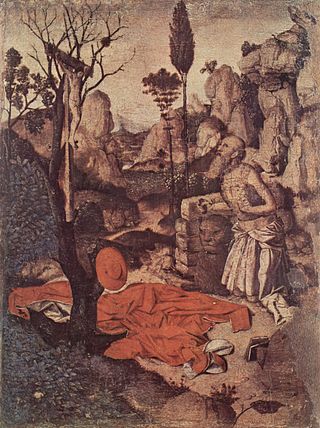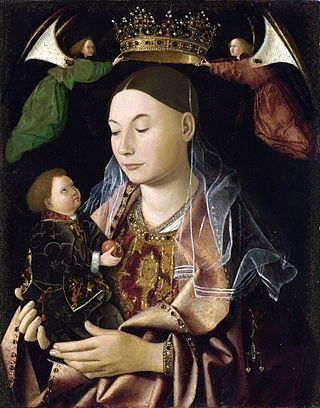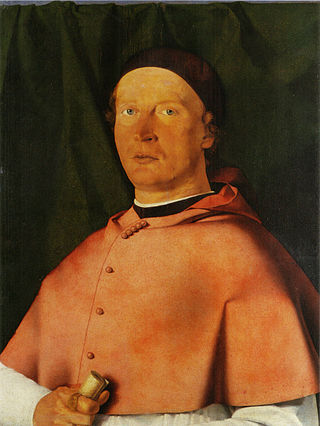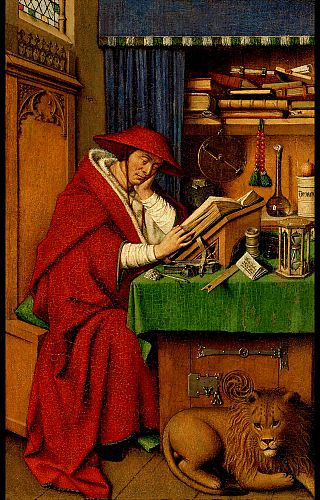
Giovanni Bellini was an Italian Renaissance painter, probably the best known of the Bellini family of Venetian painters. He was raised in the household of Jacopo Bellini, formerly thought to have been his father, but now that familial generational relationship is questioned. An older brother, Gentile Bellini was more highly regarded than Giovanni during his lifetime, but the reverse is true today. His brother-in-law was Andrea Mantegna.

Antonello da Messina, properly Antonello di Giovanni di Antonio, but also called Antonello degli Antoni and Anglicized as Anthony of Messina, was an Italian painter from Messina, active during the Italian Early Renaissance.

Renaissance art is the painting, sculpture, and decorative arts of the period of European history known as the Renaissance, which emerged as a distinct style in Italy in about AD 1400, in parallel with developments which occurred in philosophy, literature, music, science, and technology. Renaissance art took as its foundation the art of Classical antiquity, perceived as the noblest of ancient traditions, but transformed that tradition by absorbing recent developments in the art of Northern Europe and by applying contemporary scientific knowledge. Along with Renaissance humanist philosophy, it spread throughout Europe, affecting both artists and their patrons with the development of new techniques and new artistic sensibilities. For art historians, Renaissance art marks the transition of Europe from the medieval period to the Early Modern age.

Vittore Carpaccio (UK: /kɑːrˈpætʃ oʊ/, US: /-ˈpɑːtʃ-/, Italian: [vitˈtoːre karˈpattʃo]; was an Italian painter of the Venetian school who studied under Gentile Bellini. Carpaccio was largely influenced by the style of the early Italian Renaissance painter Antonello da Messina, as well as Early Netherlandish painting. Although often compared to his mentor Gentile Bellini, Vittore Carpaccio's command of perspective, precise attention to architectural detail, themes of death, and use of bold color differentiated him from other Italian Renaissance artists. Many of his works display the religious themes and cross-cultural elements of art at the time; his portrayal of St. Augustine in His Study from 1502, reflects the popularity of collecting "exotic" and highly desired objects from different cultures.

Colantonio was an Italian painter, who was the outstanding native figure in the art of Naples in the Early Renaissance.

Petrus Christus was an Early Netherlandish painter active in Bruges from 1444, where, along with Hans Memling, he became the leading painter after the death of Jan van Eyck. He was influenced by van Eyck and Rogier van der Weyden and is noted for his innovations with linear perspective and a meticulous technique which seems derived from miniatures and manuscript illumination. Today, some 30 works are confidently attributed to him. The best known include the Portrait of a Carthusian (1446) and Portrait of a Young Girl ; both are highly innovative in the presentation of the figure against detailed, rather than flat, backgrounds.

Vivarini is the surname of a family of painters from Murano (Venice), who produced a great quantity of work in Venice and its neighborhood in the 15th century, leading on to that phase of the school which is represented by Carpaccio and the Bellini family.

Saint Sebastian is a painting, once part of a triptych by the Italian Renaissance artist Antonello da Messina, completed in 1477–1479. It is housed in the Gemäldegalerie Alte Meister, Dresden, Germany.

Christ at the Column is a small painting by the Italian Renaissance artist Antonello da Messina, executed c. 1476–1478, showing the Flagellation of Christ. It is in the Louvre in Paris.

Italian Renaissance painting is the painting of the period beginning in the late 13th century and flourishing from the early 15th to late 16th centuries, occurring in the Italian Peninsula, which was at that time divided into many political states, some independent but others controlled by external powers. The painters of Renaissance Italy, although often attached to particular courts and with loyalties to particular towns, nonetheless wandered the length and breadth of Italy, often occupying a diplomatic status and disseminating artistic and philosophical ideas.

This article about the development of themes in Italian Renaissance painting is an extension to the article Italian Renaissance painting, for which it provides additional pictures with commentary. The works encompassed are from Giotto in the early 14th century to Michelangelo's Last Judgement of the 1530s.

Saint Jerome Penitent and Abraham Served by Three Angels are two paintings by the Italian Renaissance master Antonello da Messina. They are housed in the Pinacoteca Civica, Reggio Calabria.

The Madonna with Child is a painting attributed on basis of style to the early Italian Renaissance master Antonello da Messina, depicting the Madona holding the doll-like Child and wearing an ornate golden crown, held by angels over her head. It is housed in the National Gallery, London. The name Salting, which is also applied to a Madonna by Robert Campin, denotes George Salting, the collector who donated it to the gallery in 1910.

The Virgin Enthroned with Saints is a painting by the Italian Renaissance artist Luca Signorelli, dated to 1491 and housed in the Pinacoteca Comunale of Volterra, central Italy.

The San Cassiano Altarpiece is a painting by the Italian Renaissance master Antonello da Messina, dating to 1475–1476. Commissioned for the church of San Cassiano in Venice, it was disassembled in the early 17th-century and the reunited central portion is now housed in the Kunsthistorisches Museum in Vienna. It was one of the most influential paintings in the Veneto area of the time.

The Portrait of Bishop Bernardo de' Rossi is an oil-on-panel painting by the Italian High Renaissance painter Lorenzo Lotto, dating to 1505. It is housed in the National Museum of Capodimonte of Naples, southern Italy.

Saint Jerome in His Study is an oil painting on panel no larger than an oversized postcard attributed to the workshop of the early Netherlandish painter Jan van Eyck and is currently in the collection of the Detroit Institute of Arts. Purchased in 1925 by museum director Dr. W.R. Valentiner, the small Flemish painting at that time was attributed to Petrus Christus. The painting depicts St. Jerome, the 4th-century translator of the Bible, reading in his study, wearing a cardinal's dress and hat. He is surrounded by objects exemplyfying late medieval intellectual life and accompanied by the pet lion that is his common attribute.
Antonio de Saliba, or Antonello de Saliba or Resaliba, (c.1466-c.1535) was an Italian painter of the Renaissance, mainly active in Sicily and Calabria.

The Pesaro Altarpiece is an oil-on-panel painting by the Italian artist Giovanni Bellini, dated to some time between 1471 and 1483. It is considered one of Bellini's first mature works, though there are doubts on its dating and on who commissioned it. The work's technique is not only an early use of oils but also of blue smalt, a by-product of the glass industry. It had already been used in the Low Countries in Bouts' 1455 The Entombment, but this marked smalt's first use in Italian art, twenty years before Leonardo da Vinci used it in Ludovico il Moro's apartments in Milan in 1492. Bellini also uses the more traditional lapis lazuli and azurite for other blues in the work.

Calvary is an oil-on-wood painting executed in 1475 by the Italian Renaissance painter Antonello da Messina. Also known as the Antwerp Crucifixion, it is now in the Royal Museum of Fine Arts, Antwerp, making it the only work by the artist in Belgium.




















